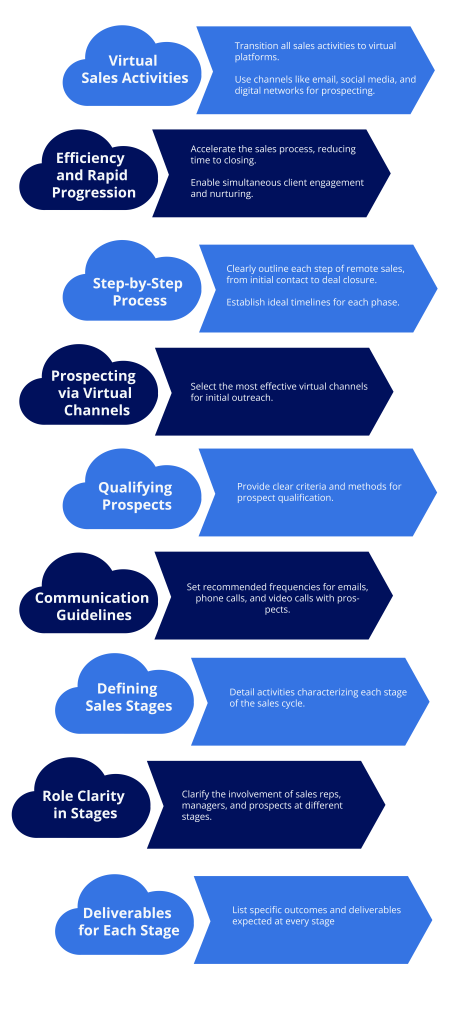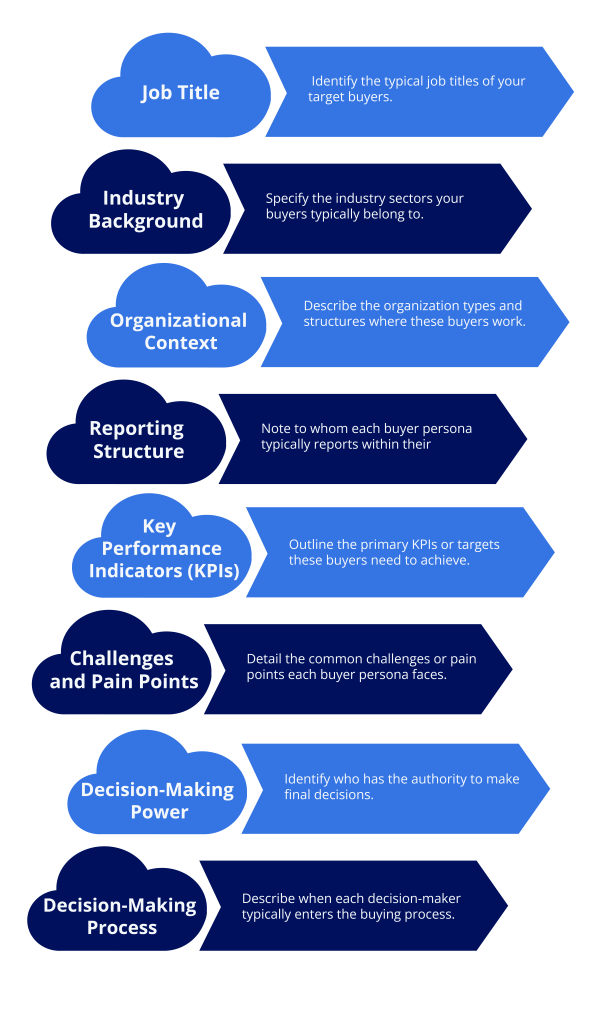A sales playbook is essential for every sales team, particularly those working remotely.
These essential documents serve as a comprehensive guide, directing Sales Development Representatives (SDRs) and ensuring consistency in their approach to prospects.
However, for remote sales teams, the challenge lies in creating a practical sales playbook and keeping it up-to-date and relevant to meet the evolving sales process demands.
In this blog post, we will outline 7 steps to create a practical sales playbook for remote teams while discussing strategies to ensure its ongoing usefulness and efficiency.
Step 1: Define Goals and Context
Setting precise goals for your sales playbook is crucial.
It’s important to comprehend the user base, how it will benefit their tasks, and how it corresponds to your overall sales and marketing objectives.
This well-planned strategy guarantees that the playbook is customized to particular necessities, making it pertinent and concentrated.
Key Considerations:
- Purpose of the Meeting:
- Determine the sales cycle stage to define the type of playbook required.
- The meeting’s purpose influences the playbook’s structure for qualifying leads, demo preparation, client onboarding, or post-sales engagement.
- Understanding Customer Pain Points:
- In discovery calls, prioritize identifying key customer pain points.
- Incorporate these insights into your playbook and objection-handling strategies, ensuring readiness for prospect queries.
- Use focused frameworks to maintain clarity during sales conversations.
- Enhancing Customer Engagement and Retention:
- Employ visuals, websites, and interactive presentation tools to boost customer engagement.
- Experiment with various engagement techniques to find what works best for your team and customers.
- Integration of interactive elements in your playbook can significantly enhance customer experience.
- Preparation for Objections:
- Communicate common objections and challenges across the sales team.
- Include comprehensive FAQs and response strategies in your playbook for preparedness.
- Document and review objections post-call for continuous learning and playbook refinement.
- Collecting Customer Information:
- Prepare specific questions to extract crucial information during customer interactions.
- Use this information to steer the conversation effectively and stay aligned with customer needs.
- Automate the capturing of key discussion points for efficient follow-up and CRM updating.
- Collaboratively determine next steps with customers, documenting potential challenges and plans for future interactions.
Step 2: Incorporate Comprehensive Company and Product Information
A well-designed sales playbook should begin with a comprehensive overview of your company.
The primary objective of this overview is to provide new employees with a clear understanding of your organization’s structure, particularly the sales department. This foundation aligns team members with the company’s vision and strategy.
Company Overview:
- Company Details:
- Provide basic facts about the company’s history, mission, and values.
- Explain the company’s structure, highlighting different departments and their functions.
- Sales Department Insight:
- Detail the structure of the sales department, including roles and responsibilities.
- Outline the career path and progression opportunities for sales reps.
- Remote Sales Playbook Version:
- Use creative methods like videos and infographics for an engaging company overview presentation.
- Ensure the content is both informative and exciting to maintain engagement.
Product Information:
- Product Listings:
- Enumerate all products and services that sales reps will be marketing.
- For remote sales playbooks, ensure sales reps can access product collaterals and engage with the content.
- Engagement Techniques:
- Leverage videos where subject matter experts explain each product.
- Cover features, advantages, benefits, use cases, core value offerings, and pricing in the videos.
- Target Audience and Industries:
- Describe the buyers and end customers for each product.
- Identify industries or verticals most likely to use the product.
- Discuss competitive products in the market.
- Key Question for Each Product:
- Address the fundamental question: “What is your product, and why should customers choose it over alternatives?”
- Address the fundamental question: “What is your product, and why should customers choose it over alternatives?”
Bonus tip: Create different playbooks for each product if your company has diverse product lines with varying buying processes, mainly if various sales team members sell them.
Step 3: Detail Sales Process and Methodology
Sales process and methodology are vital in a sales playbook, especially for remote teams.
Consider the following key points when defining your process:

Step 4. Outline Tools and Technologies
Remote sales require a broader range of tech tools than traditional sales. Every remote sales team must have tools for prospecting, closing deals, and collaboration.
The necessary tools include:
- CRM System:
- Central tool for managing customer and prospect data.
- Include guides for data entry, tracking interactions, and managing sales pipelines.
- Sales Training/Coaching Platform:
- Facilitates remote sales training and skill development.
- Provide access and usage instructions for continuous learning and performance improvement.
- Sales Performance Management System:
- Tracks individual sales performance and rewards accomplishments.
- Detail how to monitor goals and achievements and receive feedback.
- Video Conferencing Tool (e.g., Zoom):
- Essential for virtual meetings with customers and prospects.
- Include best practices for setting up, conducting, and following up on virtual meetings.
- Team Communication and Collaboration Tool (e.g., Slack):
- Enables seamless collaboration with teammates and managers.
- Offer tips on organizing channels, compelling messaging, and integrating with other tools.
- Resource Sharing Tool (e.g., Google Drive):
- For sharing and accessing shared documents and resources.
- Guide on organizing files, sharing protocols, and maintaining version control.
Step 5: Create Buyer Personas and Communication Strategies
Developing detailed buyer personas for your Sales Playbooks is crucial in guiding your sales team to identify and effectively target the ideal customers.
In a remote sales playbook, the details of buyer personas are vital for honing in on the most qualified leads.
Key aspects to consider:

Pro-tip: Include specific qualification criteria for each buyer persona, such as the ability to purchase within a set timeframe or having a sufficient budget.
Step 6. Include Resources in the Sales Playbook
Sales play, and resources are essential components of a sales playbook. They equip Sales Development Representatives (SDRs) with concrete strategies to communicate your brand message to prospects and customers efficiently.
Ensure that your sales playbook includes the following elements:
- Messaging Samples:
- Include email templates, positioning statements, phone call scripts, and sample presentation decks. For example, a key component is a script to introduce to a prospect, such as “Hello, my name is Stephen, and I’m following up regarding your interest in Worldwide Marketing.”
- Include email templates, positioning statements, phone call scripts, and sample presentation decks. For example, a key component is a script to introduce to a prospect, such as “Hello, my name is Stephen, and I’m following up regarding your interest in Worldwide Marketing.”
- Introduction Techniques:
- Guide on introducing oneself to new prospects on social media, WhatsApp, video calls, and virtual events.
- Emphasize authenticity and professionalism in these introductions.
- Building Trust Virtually:
- Strategies for establishing and maintaining trust in a virtual sales environment.
- Strategies for establishing and maintaining trust in a virtual sales environment.
- Strategic Questioning:
- Guide on asking insightful questions during video calls to uncover customer needs.
- Guide on asking insightful questions during video calls to uncover customer needs.
- Virtual Product Demos:
- Include instructions and scripts on how to schedule a product demo meeting. These instructions should be clear and straightforward, with examples provided.
- Include instructions and scripts on how to schedule a product demo meeting. These instructions should be clear and straightforward, with examples provided.
For instance, you could include sample scripts such as “We could set up a demo for tomorrow afternoon, or when would be the best time to reach you?”
- Handling Objections:
- Provide a list of common objections at different sales stages and offer tactics for efficiently addressing and overcoming these objections. Include scripts as the following:
Hello, [Prospect’s Name], I’m [Your Name] with [Company Name].
We were in touch a few [days/weeks] ago about our new product, and I wanted to follow up to see if you had any questions.
I understand that you’re hesitant because of [objection]. This is not a sales call, and I’m not trying to pressure you into anything.
I just want to answer any questions that you may have to help you make an informed decision. Also, if you need a separate call to discuss this with your team, I’m happy to do that.
Thank you for your time.
Step 7: Conduct Reviews and Updates on the Sales Playbooks
Regularly updating the sales playbook is important to enhance sales performance and boost customer satisfaction.
It’s crucial to monitor the impact of these updates on key sales metrics such as conversion rates, deal size, sales cycle length, win rate, retention rate, and overall revenue. Tracking the sales team’s adoption and utilization of the playbook is equally important.
Identifying potential barriers, encouraging feedback, and involving key stakeholders from various departments can help refine and optimize the playbook, making it a dynamic and practical tool for your remote sales team.
Conclusion
To summarize, a sales playbook tailored for remote teams is a flexible and constantly evolving guide that is in sync with your team’s requirements and the ever-changing sales environment.
By following these steps, you will be able to develop a playbook that not only brings success but also nurtures a culture of continuous learning and adjustment.
Frequently Asked Questions (FAQs)
How often should the sales playbooks be updated?
- Regular updates are crucial to maintain relevance. Consider reviewing the playbook quarterly.
What is the best way to train remote sales teams using the playbook?
- Use a mix of written content, video tutorials, and regular training sessions.








